Life and work
They married in 1969 but met in 1965. From then on they both worked creatively closely together and from since 1999 as a duo. In 1965 their Heart was created and in 1970 their first joint artproject The Circle of Angels arose, a colorful environment of large polyester statues. Since 1974 their work has the theme of 'The Plant' as a metaphor for man.
Starting in 1995 they built The Tempelhof, a culmination of their life and work and since 2018 honoured as Dutch Cultural Heritage. The Anima Mundi initiated project in 1984 and is in development for further realization. An already realised large project of them is The Unifying Spiritual Field of the World (1991). Since 2002 they have worked together on The Spiritual Garden as an imagination of the five world religions + the garden of universal spirituality, by which they find inspiration in the symbolism of numbers.
They are known for large projects but also for many monumental statues in the Netherlands and in other countries, that often are realised in corten steel. Their works are found mainly in the Netherlands but also in Belgium, Switzerland, Germany, France, England, Dubai and Palestine. The philosophy behind their work is in 2012 expressed in the Manifest Utopia: Life as Work of Art. In 2015 The World my Garden. In 2018 Manifest Quantum Art 2018.

Nijmegen is the largest city in the Dutch province of Gelderland and the tenth largest of the Netherlands as a whole. Located on the Waal River close to the German border, Nijmegen is the oldest city in the Netherlands and the first to be recognized as such in Roman times. In 2005, it celebrated 2,000 years of existence.

Arnhem is a city and municipality situated in the eastern part of the Netherlands. It is the capital of the province of Gelderland, located on both banks of the rivers Nederrijn and Sint-Jansbeek, which was the source of the city's development. Arnhem had a population of 163,972 on 1 December 2021, which made it one of the larger cities of the Netherlands. The municipality is part of the Arnhem–Nijmegen metropolitan area, which has a combined number of 774,506 inhabitants on 31 January 2022.
The polder model is a method of consensus decision-making, based on the Dutch version of consensus-based economic and social policymaking in the 1980s and 1990s. It gets its name from the Dutch word (polder) for tracts of land enclosed by dikes.
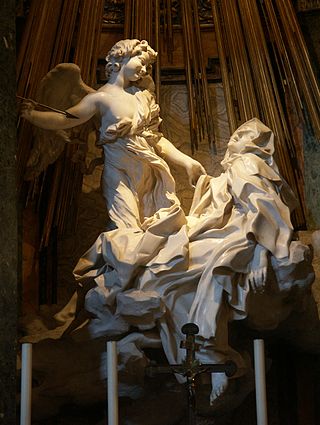
Baroque sculpture is the sculpture associated with the Baroque style of the period between the early 17th and mid 18th centuries. In Baroque sculpture, groups of figures assumed new importance, and there was a dynamic movement and energy of human forms—they spiralled around an empty central vortex, or reached outwards into the surrounding space. Baroque sculpture often had multiple ideal viewing angles, and reflected a general continuation of the Renaissance move away from the relief to sculpture created in the round, and designed to be placed in the middle of a large space—elaborate fountains such as Gian Lorenzo Bernini‘s Fontana dei Quattro Fiumi, or those in the Gardens of Versailles were a Baroque speciality. The Baroque style was perfectly suited to sculpture, with Bernini the dominating figure of the age in works such as The Ecstasy of St Theresa (1647–1652). Much Baroque sculpture added extra-sculptural elements, for example, concealed lighting, or water fountains, or fused sculpture and architecture to create a transformative experience for the viewer. Artists saw themselves as in the classical tradition, but admired Hellenistic and later Roman sculpture, rather than that of the more "Classical" periods as they are seen today.
Jules de Goede was a Dutch abstract artist and art lecturer who spent most of his life in Australia and England.

Hanneke Beaumont is a Dutch sculptor known for her large scale figurative works in terracotta, bronze and cast iron.

The Human Rights Tulip is an annual prize awarded by the Dutch ministry of Foreign Affairs to a human rights defender or organisation who promotes and supports human rights in innovative ways. The Human Rights Tulip was established in 2007 and presented for the first time on 10 December 2008 and designed by the artist duo Adelheid and Huub Kortekaas.

Jan Baptist Xavery or Jan Baptist Xavery was a Flemish sculptor principally active in the Dutch Republic. He produced portrait busts, large scale statues for residences and gardens, church furniture, wall decorations, tomb monuments as well as small scale statuettes in boxwood, lime wood, ivory and terracotta. The latter were made for elite collectors who liked to admire such objects in the privacy of their homes. He worked on various projects for William IV of Orange-Nassau, the Prince of Orange who later became the Stadtholder. He is regarded as the leading sculptor active in the Dutch Republic in the first half if the 18th century.
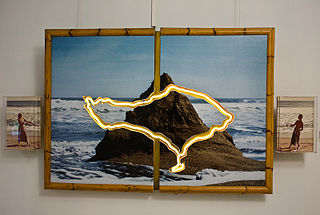
Wilhelmus Josephus (Woody) van Amen is a Dutch sculptor, painter and collage artist.
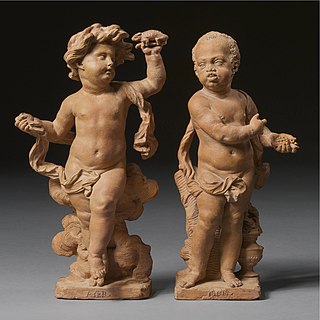
Jan Claudius de Cock was a Flemish painter, sculptor, print artist and writer. De Cock produced both religious and secular sculpture on a small as well as monumental scale. De Cock completed many commissions in the Dutch Republic. He worked on decorations for the courtyard of the Breda Palace for William III, King of England, Ireland, and Scotland and stadtholder. He is credited with introducing neoclassicism in Flemish sculpture. He was a prolific draughtsman and designed prints for the Antwerp publishers. As a writer, he wrote a poem about the 1718 fire in the Jesuit Church in Antwerp and a book of instructions on the art of sculpture.

Antonius Stanislaus Nicolaas Ludovicus Dupuis was a Dutch sculptor and medallist of Belgian origin.
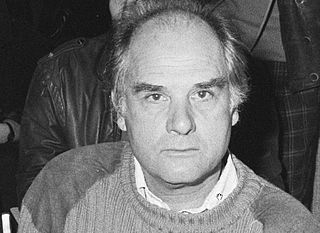
Carel Nicolaas Visser was a Dutch sculptor. He is considered an important representative of Dutch abstract-minimalist constructivism in sculpture.
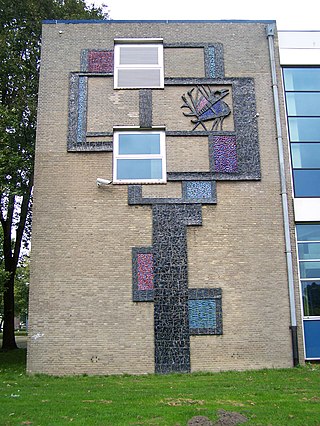
Martinus Johannes (Jan) van Druten was a Dutch painter, sculptor and ceramist.
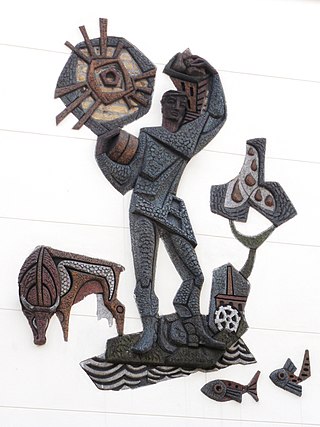
Josephus Theodorus (Joop) Puntman was a Dutch ceramist and sculptor.

Johannes Jacobus (Joop) Beljon was a Dutch artist, academy lecturer, director of academy and writer. As artist he was active as sculptor, fiber artist, lithographer, jeweler, environmental artists, and jewelry designer. Under the name J.J. Beljon and the pseudonym Bernard Majorick, Beljon was also writer. Beljon had taken over that pseudonym from the writer Godfried Bomans.

Laurys Gillis or Laurent Gillis was a Flemish sculptor who was active in Antwerp in the first half of the 18th century. He worked for a long time in the workshop of the prominent Antwerp sculptor Michiel van der Voort the Elder. He is known for statues of historical and biblical figures, Christian saints and allegorical respresentations.

Bartholomeus Eggers was a Flemish sculptor, who after training in his hometown Antwerp spent most of his active career in the Dutch Republic. Here he initially collaborated with other Flemish sculptors on the sculptural decorations for the new city hall in Amsterdam, a project which was under the direction of Artus Quellinus the Elder. He worked on various public projects and on commissions for leading courts in Europe. He is known for his portraits, funerary sculptures, reliefs, statues of children and allegorical, biblical and mythological sculptures. He was, together with Artus Quellinus the Elder and Rombout Verhulst, one of the leading sculptors active in the Dutch Republic in the second half of the 17th century.

Albert Xavery, Albert Saverij or Albertus Xavery was a Flemish sculptor principally active in Antwerp. He produced mainly statues of mythological figures, some of them on a large scale, made to be displayed in luxurious residences or in gardens. Like other Antwerp sculptors, he exported many of his works to the Dutch Republic, where his patrons included members of the House of Nassau.

Jan Frans van Geel was a Flemish sculptor, draugthsman and art educator. He is mainly known for his church furniture, statues of saints, mythological ensembles and allegorical figures. He was a teacher and director at the Academy of Arts of Mechelen and teacher of sculpture at the Academy of Arts of Antwerp. He was one of the last Flemish sculptors who worked in the Flemish Baroque style in sculpture, which was popular in the Habsburg Netherlands in the 17th and 18th centuries.


















